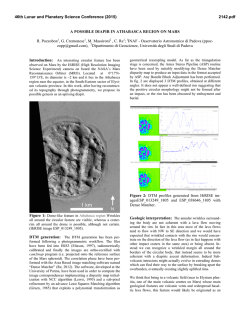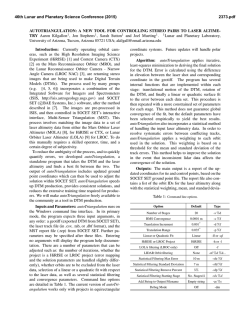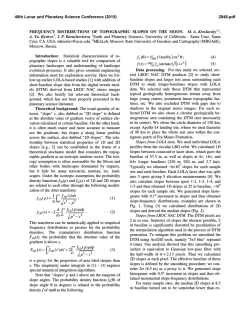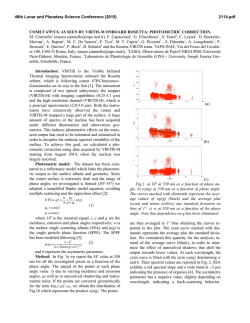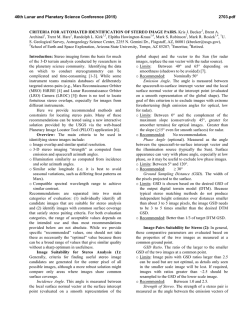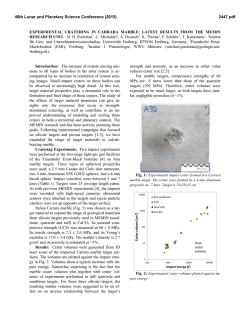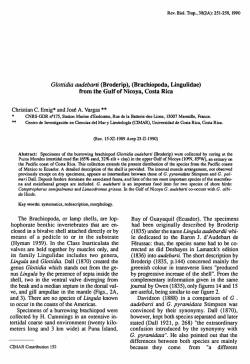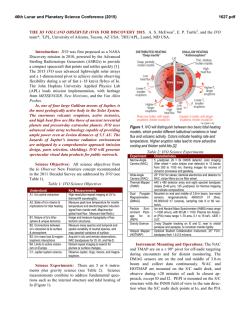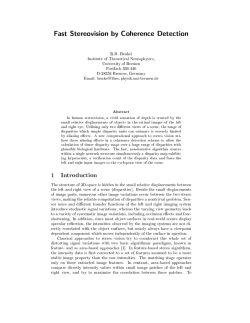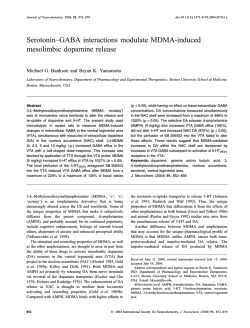
Construction of very high resolution DTMs based on NAC images
46th Lunar and Planetary Science Conference (2015) 1787.pdf Construction of very high resolution DTMs based on NAC images using stereo analysis and shape from shading: A first glance. A. Grumpe1, C. Wöhler1, M. Liu2 and B. Wu2, 1Image Analysis Group, TU Dortmund, 44227 Dortmund, Germany ([email protected]), 2Department of Land Surveying & Geo-Informatics, The Hong Kong Polytechnic University, Hung Hom, Kowloon, Hong Kong ([email protected]). Figure 1: NAC image M173246166L. The yellow lines show the positions of the vertical (Fig. 2) and the horizontal (Fig. 3) profiles, respectively. The yellow rectangle shows the location of the crater displayed in Fig. 4. Introduction: The construction of high-resolution and highprecision lunar digital terrain maps (DTM) is essential to scientific research, e.g. morphologic analysis and planning of future landing scenarios. Here we present a method that combines stereo analysis [1] and shape from shading (SfS) [2]. The overall algorithm is applied to Lunar Reconnaissance Orbiter (LRO) Narrow Angle Camera (NAC) images to derive DTMs of an effective lateral resolution of approximately 0.5 m. Construction of DTMs: The full-resolution DTM is constructed by subsequently applying a block-matching based stereo analysis and a SfS algorithm that recovers the topography from shading information while being restricted to a DTM of lower lateral resolution. Stereo analysis. To construct the initial DTM, we apply the self-adaptive triangle-constrained image matching agorithm [3, 4]. At first, robust points are matched using the SIFT algorithm [5] and a RANSAC approach [1], and triangulations covering the overlapping area of the stereo images are created. A Harris-Laplace detector [6] is then applied to find interest points that are matched using a cross-correlation algorithm. Finally, the triangulations are dynamically updated using the newly matched points. The interest point matching is followed by a dense matching constrained by the triangulations to generate reliable and dense matching results. 3D coordinates of the matched points are obtained through the photogrammetric intersection based on the orientation parameters of the NAC images, as retrieved from the SPICE ("Spacecraft, Planet, Instrument, Cmatrix, Events") kernels [7]. A DTM with a resolution of 1.5 m is interpolated from the 3D points. Shape-from-shading (SfS). The applied SfS algorithm is a combination of a previously published SfS algorithm [8] and the retrieval of a DTM from a gradient field with respect to a DTM of lower lateral resolution that is known a-priori [9]. The algorithms are combined by replacing the gradient field integration step given in [8] with the equation presented in [9]. First, the surface gradient field is estimated based on the reflectance information of the image and DTM information of lower lateral resolution. Second, the initial DTM is updated using the gradient field of the first step and the update equation [9]. Both steps are repeated until the updated DTM does no longer change or the value of the error function does not decrease any more. Evaluation: Applying the stereo analysis, a DTM of 1.5 m lateral resolution has been derived from NAC image M173246166L. The image is shown in Fig. 1. To estimate the improvements of the DTM after application of the SfS algorithm, we compared the stereobased DTM and the SfS-based DTM for overall consistency and small-scale details. Prior to the analysis, the NAC image and the SfS-based DTM are resized to match the size of the stereo-based DTM. Figure 2: The vertical profile of the DTMs along the vertical line marked in Fig. 1. The SfS-based DTM (black line) and the stereo-based DTM (red dashed line) are in very good agreement. The three rille troughs are clearly shown in both DTMs. 46th Lunar and Planetary Science Conference (2015) Figure 3: The horizontal profile of the DTMs along the horizontal line marked in Fig. 1. The SfS-based DTM (black line) and the stereo-based DTM (red dashed line) are in very good agreement. The SfS-based DTM, however, shows jumps and drops at the image edges.. Overall consistency. The vertical and the horizontal profile marked in Fig. 1 are shown in Fig. 2 and Fig. 3, respectively. Both figures show a very good agreement between the DTMs. The horizontal profile shows two large jumps and drops in the SfS-based DTM that originate from the image edges. This is a well-known behavior of SfS algorithms and is limited to the local area next to the image boundary. Small-scale analysis. The region around the crater marked in Fig. 1 is shown in Fig. 4. The profile (Fig. 4b) and the color coded DTMs (Fig. 4c-d) show that the SfS-based DTM recovers the triangulation artifacts at the crater floor. However, it introduces rippleshaped artifacts in regions where the original NAC image shows small shadows that are cast by rocks along the crater rim. Conclusion: In this study we have shown that SfS may be applied to improve the small-scale details of stereo analysis based DTMs while the overall consistency is kept. The SfS algorithm shows smaller features and removes artifacts of the blockmatching procedure. However, it also reflects the image noise within the DTM and may produce undesirable artifacts in shadowed areas. Future work will include the replacement of the stereo-based DTM by laser altimetry and a further assessment of the vertical accuracy. References: [1] Hartley, R. and Zisserman, A. (2003) Multiple View Geometry in Computer Vision, Cambridge University Press. [2] Horn, B. K. P. (1990) International Journal of Computer Vision 5(1), 37-75. [3] Wu, B., Zhang, Y. and Zhu, Q. (2011) IEEE Trans. on Geoscience and Remote Sensing, 77(7), 695–708. [4] Wu, B., Zhang, Y. and Zhu, Q. (2012) ISPRS Journal of Photogrammetry and Remote Sensing, 68, 40– 55. [5] Lowe, D. G. (2004) International Journal of 1787.pdf Figure 4: The region of interest around the crater marked in Fig. 1. (a) NAC image of the crater. (b) Profile of the SfS-based and the stereo-based DTM, respectively. The profile follows the yellow line in (a). (c)-(d) SfS-based and stereo-based DTM, respectively. The height is color-coded and a Lambertian shading is overlaid. It is clearly visible that the SfS-based DTM recovers the data where the stereo-based DTM shows artifacts. There are, however, minor artifacts in the SfS-based DTM where the original image shows cast shadows. Computer Vision, 60(2), 91-110. [6] Zhu, Q., Wu, B. and Wan, N. (2007) Photogrammetric Engineering & Remote Sensing, 62(4), 295-308. [7] Acton, C. (1998) http://pirlwww.lpl.arizona.edu/resources/guide/ software/SPICE/old_tutorials/SPICE_Overview.pdf [8] Grumpe, A., Belkhir, F. and Wöhler, C. (2014), Advances in Space Research, 53(12), 1735-1767. [9] Grumpe, A. and Wöhler, C. (2014) ISPRS Journal of Photogrammetry and Remote Sensing, 94, 37-54.
© Copyright 2025
